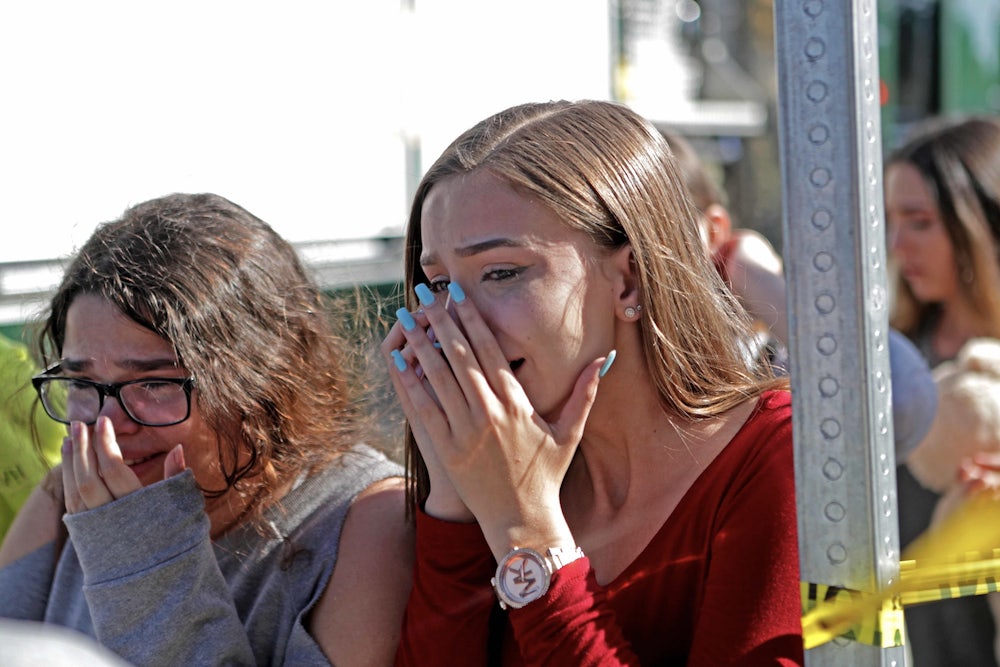About a year ago, in his inaugural address, President Donald Trump described the nation in apocalyptic terms and presented himself as its savior. “Mothers and children trapped in poverty in our inner cities; rusted-out factories scattered like tombstones across the landscape of our nation; an education system, flush with cash, but which leaves our young and beautiful students deprived of knowledge; and the crime and gangs and drugs that have stolen too many lives and robbed our country of so much unrealized potential,” he said, before drawing a deep breath through his clenched nostrils. “This American carnage stops right here and stops right now.”
Despite all this talk of crime and tombstones, of schools and stolen lives, he did not once in his speech say the word “guns.”
On Wednesday, a 19-year-old who had been expelled from Marjory Stoneman Douglas High School in Parkland, Florida, reportedly returned to the building wearing a gas mask and armed with a semiautomatic AR-15 rifle, “countless magazines” of ammunition, and smoke grenades. He pulled the fire alarm, his former classmates spilled into the hallways, and he proceeded to massacre them. Here’s how The New York Times described the scene:
Students huddled in horror in their classrooms, with some of them training their cellphones on the carnage, capturing sprawled bodies, screams and gunfire that began with a few shots and then continued with more and more. The dead included students and adults, some of whom were shot outside the school and others inside the sprawling three-story building.
But you can also see the horror for yourself:
Last October’s mass shooting at a country music concert in Las Vegas made clear how deeply America has become inured to such violence and how politically intractable the issue of gun control has become. That was the deadliest shooting in U.S. history, with 58 killed and and 851 injured, and while the story led the news for several days, the debate in Washington centered around a policy solution—banning “bump stocks,” which effectively turn semiautomatic weapons into automatic ones—that might have limited the fatalities in Las Vegas but would have done nothing to prevent it (or the many thousands of others that have occurred over the past two decades). Congress, being run by Republicans who oppose nearly all restrictions on gun ownership, couldn’t even manage to accomplish that much.
What happened? The National Rifle Association, which initially appeared to support the bump-stock ban, later (and more quietly) opposed it.
So the nation returns to a familiar routine. Teenagers are slaughtered at their desks, and our leaders offer their “thoughts and condolences,” as if someone’s 96-year-old grandparent has passed away in her sleep:
My prayers and condolences to the families of the victims of the terrible Florida shooting. No child, teacher or anyone else should ever feel unsafe in an American school.
— Donald J. Trump (@realDonaldTrump) February 14, 2018
And the Republicans, knowing they will be blamed for opposing any sensible gun reform, argue with a straight face that limiting gun ownership won’t necessarily limit mass murder—
Rubio: We shouldn't "jump to conclusions" that gun control laws would've prevented Florida school shooting https://t.co/6MGNBPHpJU pic.twitter.com/whMRj1riXv
— The Hill (@thehill) February 15, 2018
—or insist that America’s mass-shooting epidemic is a mental health issue, not a gun issue:
So many signs that the Florida shooter was mentally disturbed, even expelled from school for bad and erratic behavior. Neighbors and classmates knew he was a big problem. Must always report such instances to authorities, again and again!
— Donald J. Trump (@realDonaldTrump) February 15, 2018
All told, 17 people were killed in yesterday’s massacre in Florida, and that’s just a fraction of the average number of Americans killed by guns every day: 96, including an average of seven children and teenagers. Already this year, there have been at least five school shootings, and 41 mass shootings in total. You, the average American, are 25 times more likely to be murdered by a gun than your peers in other developed countries.
There’s a common refrain of the Trump era: “This is not normal.” But many of the nation’s abnormalities predate this president. It is not normal how many children in the United States—many of them as young as six—have been gunned down in their classrooms. And it is not normal how many adults have been murdered at work or at church or at a concert or on the street. Theirs are the tombstones that the nation must rally around.
